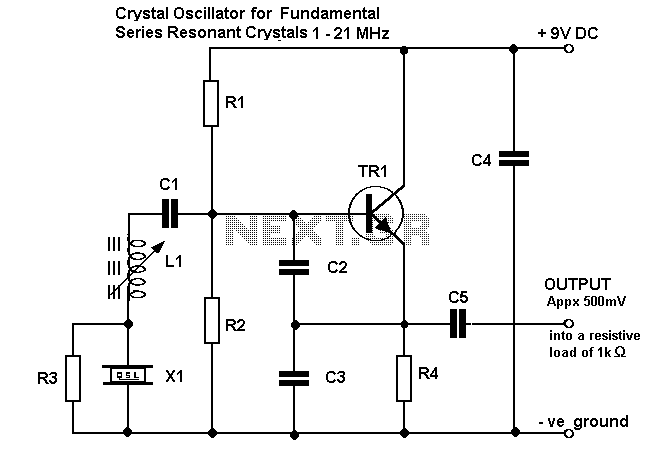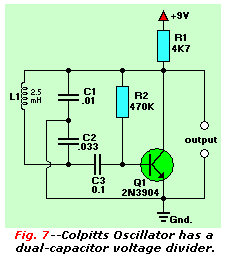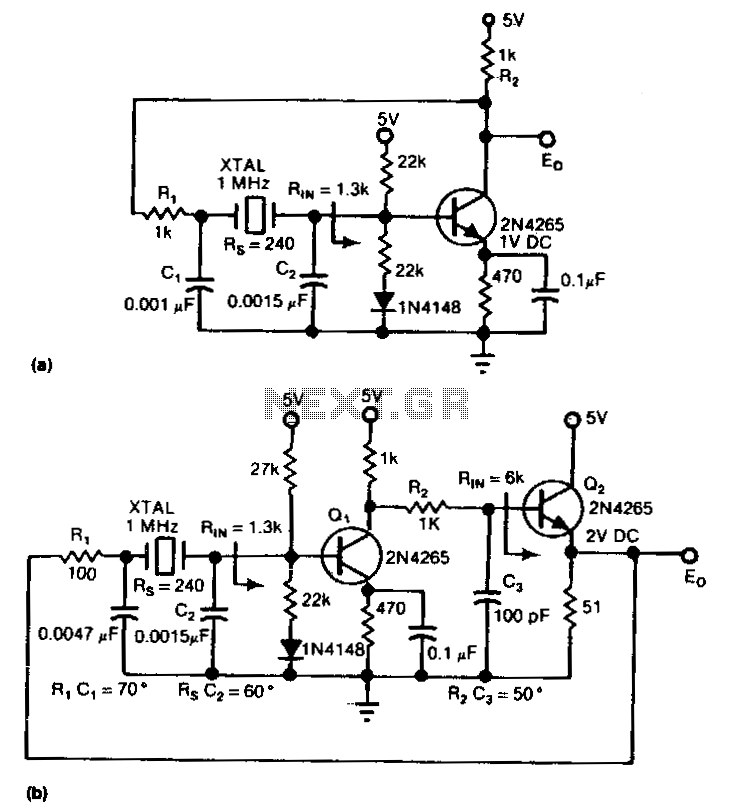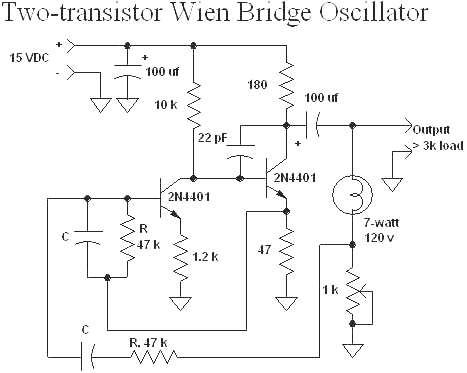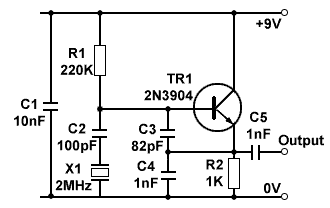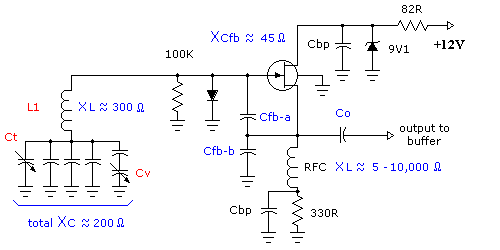
Oscillators
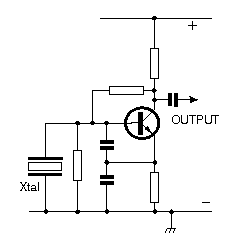
The variations, which effectively form an alternating signal, will be transmitted through the coupling capacitor to the subsequent stage, indicated by the arrow to the right. One variable resistor can be substituted with another. R1 can be replaced with any of the devices illustrated in the following diagram, each capable of acting as a variable resistor. Additional connections must be made to the other terminals of each device to bias it for proper operation, allowing the input signal to modulate the bias, which subsequently alters the internal resistance of the device. This change influences the voltage at point A, which is then transmitted through the coupling capacitor to the next stage for further processing. The two resistors connected to the base of the transistor, along with the resistor in the emitter, create the biasing arrangements. These components establish the current flowing through the primary of the transformer, known as the collector current. An input audio signal is introduced via a coupling capacitor to the base of the transistor, which modulates the base current, thereby affecting the effective resistance of the transistor and, consequently, the collector current. The circuit depicted below is a typical radio frequency amplifier for a transmitter. The load consists of all components linked to the collector of transistor Q1, including C5, L2, and the antenna or any output connection. The RF choke RFC2 supplies 12V DC to the device while preventing RF interference from entering the power supply lines. The input signal provides self-biasing for the transistor. Conditions for oscillation require that the feedback signal level is sufficient and in the correct phase to maintain oscillation, constituting positive feedback. This feedback is sourced from a secondary coil, which injects a signal into the base lead, altering the base current. If the secondary coil is properly polarized, the circuit will oscillate. The subsequent diagram illustrates an audio amplifier (represented as a triangle with gain indicated by the arrow) and a feedback network—a collection of resistors and capacitors forming a bridged-T network—connected between the output and input. This serves as a diagrammatic representation of an audio oscillator. Various feedback networks exist, utilizing a wide array of components. Typically, upon initial activation, an oscillator self-starts due to a burst of noise or a similar transient at the input of the amplifying device, triggering oscillation. The diagram also represents an oscillator. The lower end of coil L1 connects to the source and drain current path, and transformer action induces changes in the base current. This device is self-biasing. A resistor from the collector to the base, along with a base-to-ground resistor and an emitter resistor, supplies some DC bias (base current) for optimal operation. When these diodes are reverse-biased, the depletion region between the anode and cathode becomes a dielectric, with its width dependent on the applied voltage. A variation in the applied voltage modifies the dielectric width, thereby altering the capacitance between the anode and cathode. The configuration shown allows the frequency of the oscillator to be adjusted by changing the voltage at the wiper (moving arm) of the manual tuning potentiometer. The 100k resistor located at the junction of the two diodes prevents RF from contaminating the DC line. The diagram also illustrates the principle of the phase-locked loop (PLL), which comprises a voltage-controlled oscillator providing the output frequency. This frequency is compared with that of a reference oscillator using a phase detector or comparator. To ensure the output frequency matches the reference oscillator, the output frequency is routed through a divide-by-one stage to the phase detector. If the frequencies differ, an error voltage proportional to the frequency difference is generated. This voltage is filtered.
The described circuit components and their interactions form the basis for various applications in electronic systems, particularly in amplification and oscillation scenarios. The coupling capacitor serves as a crucial element in signal transmission, allowing for the passage of AC signals while blocking DC components. The variable resistors provide flexibility in adjusting the circuit's response to input signals, enabling fine-tuning of performance characteristics.
The transistor's biasing arrangements are fundamental to its operation, ensuring that it remains within the active region for amplification. The collector current, influenced by the input audio signal, is critical for driving the connected load, which may include an antenna in RF applications. The RF choke plays an essential role in maintaining the integrity of the power supply by filtering out high-frequency noise, thereby enhancing the stability of the circuit.
In oscillators, the feedback mechanism is vital for sustaining oscillation. The secondary coil's feedback must be appropriately phased to reinforce the oscillation process. The self-biasing feature of the circuit simplifies the design by reducing the need for external biasing components. Additionally, the tuning potentiometer allows for precise frequency adjustments, catering to different operational requirements.
The phase-locked loop (PLL) configuration exemplifies advanced control techniques, where the output frequency is dynamically adjusted to match a reference. This capability is essential in applications such as frequency synthesis and modulation, where precise frequency control is paramount. Overall, the interconnected nature of these components illustrates the complexity and sophistication of modern electronic circuits, highlighting their roles in achieving desired operational outcomes.Those variations, (in effect an alternating signal), will be passed via the coupling capacitor to the next stage - shown by the arrow to the right. We can replace one variable resistor with another. Consider R1 to now be replaced with any one of the devices shown in this following diagram. Each can act as a variable resistor: Other connections mus t be made to the other electrodes of each device to bias it for correct operation so that the input signal can vary the bias which alters the internal resistance of the device, which: in turn varies the voltage at point A, which is passed on through the coupling capacitor to the next stage for further processing. The two resistors connected to the base of this transistor with the resistor in the emitter, form the biasing arrangements.
These components set the level of the current flowing through the primary of the transformer - the collector current. An input audio signal is fed via a coupling capacitor to the base of the transistor. This varies the base current which in turn varies the effective resistance of the transistor and hence the collector current.
The circuit below is a typical transmitter radio frequency amplifier. Here the load comprises all the components connected to the collector of the transistor Q1 - C5, L2, etc. and the antenna or whatever is connected to the output. The RF choke RFC2 feeds 12v DC to the device and prevents the RF from getting into the power supply leads.
The input signal provides self-bias to the transistor. The conditions for oscillation are that the level of signal fed back is at an adequate level, and that the signal is in the correct phase to sustain oscillation. This is positive feedback. The feedback is taken by a secondary coil and inserts a signal in the base lead, changing the base-current.
Provided the secondary coil is correctly polarised, the circuit will oscillate. This next diagram shows an audio amplifier (the triangle - with gain in the direction of the arrow) and a feedback network - the collection of resistors and capacitors - a bridged-tee network - connected between the output and the input. This again is a diagrammatic illustration of an audio oscillator. There are many different feedback networks used and they can comprise a wide range of components of all types.
In practice, when first switching on, an oscillator will usually self-start because a burst of noise or a similar transient at the input to the amplifying device is enough for it to commence oscillation. This diagram is also an oscillator. The bottom end of the coil L1 is common to the source and drain current path and transformer action will cause changes in the base current.
This device is self-biasing. A resistor from the collector to the base and from base to earth, together with the emitter resistor, provides some DC bias (base current) for correct operation. When these diodes are reverse-biased, the depletion region between anode and cathode becomes a dielectric whose width is dependent on the applied voltage.
A change of applied voltage changes the width of the dielectric thereby changing the capacitance between anode and cathode. Connected as shown, changing the voltage at the wiper (moving arm) of the manual TUNING potentiometer shown will change the frequency of the oscillator.
The 100k resistor at the junction of the two diodes is to prevent any RF from entering the DC line. This diagram shows the principle of the phase-locked loop (PLL). It consists of a voltage-controlled oscillator which provides the output frequency. That frequency is compared to a reference oscillator using a phase detector or comparator. If we want the output frequency to be the same as the reference oscillator we pass the output frequency through a divide-by-one stage to the phase detector. If the frequencies are not the same, an error voltage proportional to the difference in frequency is produced.
This voltage is filter 🔗 External reference
The described circuit components and their interactions form the basis for various applications in electronic systems, particularly in amplification and oscillation scenarios. The coupling capacitor serves as a crucial element in signal transmission, allowing for the passage of AC signals while blocking DC components. The variable resistors provide flexibility in adjusting the circuit's response to input signals, enabling fine-tuning of performance characteristics.
The transistor's biasing arrangements are fundamental to its operation, ensuring that it remains within the active region for amplification. The collector current, influenced by the input audio signal, is critical for driving the connected load, which may include an antenna in RF applications. The RF choke plays an essential role in maintaining the integrity of the power supply by filtering out high-frequency noise, thereby enhancing the stability of the circuit.
In oscillators, the feedback mechanism is vital for sustaining oscillation. The secondary coil's feedback must be appropriately phased to reinforce the oscillation process. The self-biasing feature of the circuit simplifies the design by reducing the need for external biasing components. Additionally, the tuning potentiometer allows for precise frequency adjustments, catering to different operational requirements.
The phase-locked loop (PLL) configuration exemplifies advanced control techniques, where the output frequency is dynamically adjusted to match a reference. This capability is essential in applications such as frequency synthesis and modulation, where precise frequency control is paramount. Overall, the interconnected nature of these components illustrates the complexity and sophistication of modern electronic circuits, highlighting their roles in achieving desired operational outcomes.Those variations, (in effect an alternating signal), will be passed via the coupling capacitor to the next stage - shown by the arrow to the right. We can replace one variable resistor with another. Consider R1 to now be replaced with any one of the devices shown in this following diagram. Each can act as a variable resistor: Other connections mus t be made to the other electrodes of each device to bias it for correct operation so that the input signal can vary the bias which alters the internal resistance of the device, which: in turn varies the voltage at point A, which is passed on through the coupling capacitor to the next stage for further processing. The two resistors connected to the base of this transistor with the resistor in the emitter, form the biasing arrangements.
These components set the level of the current flowing through the primary of the transformer - the collector current. An input audio signal is fed via a coupling capacitor to the base of the transistor. This varies the base current which in turn varies the effective resistance of the transistor and hence the collector current.
The circuit below is a typical transmitter radio frequency amplifier. Here the load comprises all the components connected to the collector of the transistor Q1 - C5, L2, etc. and the antenna or whatever is connected to the output. The RF choke RFC2 feeds 12v DC to the device and prevents the RF from getting into the power supply leads.
The input signal provides self-bias to the transistor. The conditions for oscillation are that the level of signal fed back is at an adequate level, and that the signal is in the correct phase to sustain oscillation. This is positive feedback. The feedback is taken by a secondary coil and inserts a signal in the base lead, changing the base-current.
Provided the secondary coil is correctly polarised, the circuit will oscillate. This next diagram shows an audio amplifier (the triangle - with gain in the direction of the arrow) and a feedback network - the collection of resistors and capacitors - a bridged-tee network - connected between the output and the input. This again is a diagrammatic illustration of an audio oscillator. There are many different feedback networks used and they can comprise a wide range of components of all types.
In practice, when first switching on, an oscillator will usually self-start because a burst of noise or a similar transient at the input to the amplifying device is enough for it to commence oscillation. This diagram is also an oscillator. The bottom end of the coil L1 is common to the source and drain current path and transformer action will cause changes in the base current.
This device is self-biasing. A resistor from the collector to the base and from base to earth, together with the emitter resistor, provides some DC bias (base current) for correct operation. When these diodes are reverse-biased, the depletion region between anode and cathode becomes a dielectric whose width is dependent on the applied voltage.
A change of applied voltage changes the width of the dielectric thereby changing the capacitance between anode and cathode. Connected as shown, changing the voltage at the wiper (moving arm) of the manual TUNING potentiometer shown will change the frequency of the oscillator.
The 100k resistor at the junction of the two diodes is to prevent any RF from entering the DC line. This diagram shows the principle of the phase-locked loop (PLL). It consists of a voltage-controlled oscillator which provides the output frequency. That frequency is compared to a reference oscillator using a phase detector or comparator. If we want the output frequency to be the same as the reference oscillator we pass the output frequency through a divide-by-one stage to the phase detector. If the frequencies are not the same, an error voltage proportional to the difference in frequency is produced.
This voltage is filter 🔗 External reference
Warning: include(partials/cookie-banner.php): Failed to open stream: Permission denied in /var/www/html/nextgr/view-circuit.php on line 713
Warning: include(): Failed opening 'partials/cookie-banner.php' for inclusion (include_path='.:/usr/share/php') in /var/www/html/nextgr/view-circuit.php on line 713
